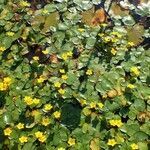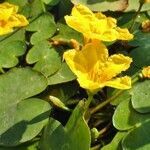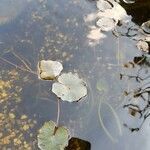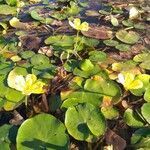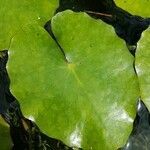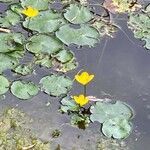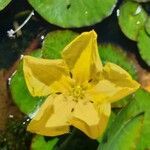Rhizomes horizontal. Stem cylindric, unbranched, sometimes producing rootlets from nodes. Leaves alternate at stem base but opposite at apex; petiole cylindric, 5-10 cm, base widened into an amplexicaul sheath; leaf blade ovate-orbicular to orbicular, 1.5-8 cm in diam., subcoriaceous, abaxially purple-brown and densely glandular, adaxially glabrous, base cordate, margin entire, veins indistinct. Flowers usually densely clustered at nodes, 5-merous, distylous. Pedicel 3-7 cm. Calyx 7-9 mm, lobed to near base; lobes elliptic-lanceolate to elliptic, apex obtuse. Corolla golden yellow, 2.5-3 cm, rotate, lobed to near base; lobes obovate, margin broadly membranous and irregularly laciniate, apex rounded to emarginate. Filaments sparsely pilose. Short styled flowers: ovary 5-7 mm; style 1-2 mm; stigma small, filaments 3-4 mm; anthers curved, sagittate, 4-6 mm. Long styled flowers: ovary 0.7-1.7 cm; style to 1 cm; stigma large, 2lobed, suborbicular; filaments 1-2 mm; anthers 2-3.5 mm. Glands golden yellow. Capsules elliptic, 1.7-2.5 × 0.8-1.1 cm. Seeds brown, compressed, elliptic, 4-5 mm, densely ciliate. Fl. and fr. Apr-Oct. 2n = 54.
More
A herb that keeps growing from year to year and has a long creeping rootstock. It grows 30 cm high and spreads 0.9-2.4 m wide. The stem are long and floating and form roots at the nodes. The leaves are floating. The leaf blade is rounded with a heart shaped base. It is 3-5 cm long by 2-6 cm wide. It has dark glands underneath and a wavy edge. The flowers are in groups in the axils. The flowers are held 5-8 cm above the water. The flowers are yellow and have a fringe. The fruit is an oval capsule. It is 18 mm long.
Stems stout, commonly 2–3 mm thick, bearing a pair of opposite, usually unequal lvs subtending the umbel, often extended and bearing additional umbels; lvs subrotund, 5–15 cm long and wide; fls heterostylic; cor bright yellow, 2–2.5 cm, its lobes somewhat fringed below; anthers 4–5 mm; fr 12–25 mm, strongly beaked; seeds flat, the margin ciliate and narrowly winged; 2n=54. Native of Europe, intr. in quiet waters here and there in our range. June–Sept.
